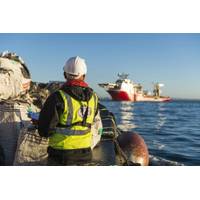Norway to Relaunch Carbon Capture Plan
By Melissa Massey and Ben Garside, Reuters
Norway's government will this spring launch a strategy to develop technology for capturing and burying heat-trapping emissions from polluting industries, aiming to make good on a pledge to build a full-size plant by 2020.
Proponents of carbon capture and storage (CCS) hope the oil-rich nation will join Britain and the Netherlands in funding a handful of schemes to keep Europe from falling behind other major economies in adopting the technology.
Europe had once aimed to take a global lead in the development of CCS, which bodies such as the International Energy Agency view as essential to meet a globally agreed goal of limiting temperature rises to 2 degrees Celsius.
"The government is currently developing a strategy for its policies on CCS and will provide an update on this process late this spring," Tord Lien, Norway's minister of petroleum and energy, said in an emailed response to questions.
He added that his right-leaning coalition government remained committed to "an aim to realise at least one full-scale carbon capture pilot plant by 2020" but declined to give further details on how this would be achieved.
The previous Labour administration spent more than 7 billion crowns ($1.2 billion) on CCS but low wholesale gas prices and cost overruns led it to drop its Mongstad gas-capture project last October just before losing power.
Public Pressure
Norway operates two smaller CCS sites and the government continues to support research at the Mongstad site with funding of 400 million crowns over four years.
However, green campaigners are sceptical about the government's determination to fund a large-scale project.
"Seeing is believing," said Frederic Hauge, president of environmental group Bellona, adding that he doubted Norway would meet its emission targets without large-scale CCS.
With greenhouse gas emissions 5 percent above 1990 levels in 2012, Norway is struggling to meet its pledge to cut output of heat-trapping gases by at least 30 percent by 2020.
But with Mongstad abandoned, it is unlikely the government will be able to complete a scheme from scratch by the end of the decade, according to Stig Schjolset, a Norway-based climate policy analyst at Thomson Reuters Point Carbon.
"There is a great deal of pressure from the public and opposition parties to have the CCS commitment met but given the long timelines I think it would be extremely difficult to have a plant in operation by 2020," he said.
Hauge added: "I am not sure that the government will survive if they do not tackle CCS."
Industry in Focus
With almost all of Norway's power generated from emission-free hydroelectric plants, the focus for a CCS plant is on capturing emissions from a cluster of heavy industries in the Grenland region in southern Norway.
"Norway really has very few options for where it could have CCS projects," Schjolset said, adding that an alternative would be for the government to fund a project abroad.
One site likely to be in the frame for funding is HeidelbergCement's Brevik plant, which has won some state funding to build a pilot facility to test different CCS options.
(Reporting by Melissa Massey and Ben Garside in London; Editing by Dale Hudson)



